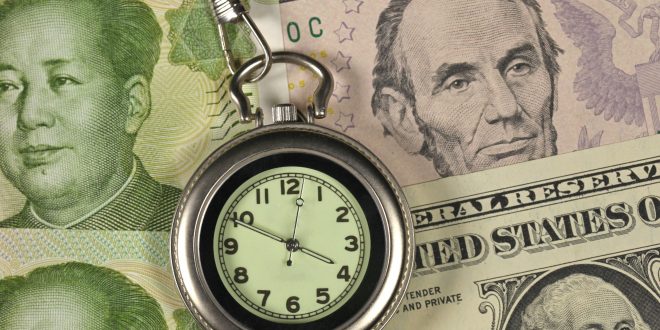Rising treasury yields continued to make the biggest effect on the market last week, amid expectations for a surge inflation due to the increased government stimulus and monetary easing policies.
Treasury yields in the United States rose last week to their highest level in about a year, with the benchmark 10-year Treasury note yield briefly touching the 1.6% level, which helped the U.S. Dollar (USD) score some gains against major rivals.
A slew of remarks by the Federal Reserve officials assured the central bank’s commitment to inflation and employment targets, led by the testimony of the Fed Chair Jerome Powell to Congress.
Powell told the Senate’s Banking Committee that the economy’s recovery is still uneven and far from complete, vowing to maintain the current monetary policy until the inflation target is achieved and full employment is reached. He also played down reflation fears, saying that there are no signs that inflation could surge out of control despite expectations for a rise in prices over the upcoming months, but most of such increases are expected to be temporary.
The USD showed some bounce last week, posting gains against most other major currencies, The Dollar finished the trading week ending on February 26 on the upside with a boost from US Treasury bond yields.
The Coronavirus continues to be a barrier to economic growth, but there is some optimism with the start of vaccine programs. In the United States, Biden’s stimulus plan was narrowly approved by the House of Representatives and remains the next hurdle in the Senate.
Oil
US bonds move on Friday sent the US dollar higher and lower oil prices, as expectations grew that, with oil prices returning to pre-pandemic levels, more supply will find its way into the market.
West Texas Intermediate crude futures fell 96 cents, or 1.5%, to $ 62.57 a barrel, giving up all Thursday’s gains. Brent crude futures for April delivery, which expire on Friday, fell 86 cents, or 1.3%, to $ 66.02 a barrel.
The appreciation of the US currency increases the cost of oil priced in dollars to buyers of crude in other currencies.
This week oil prices were impacted by the lasting impact of the winter storm that halted major production and refining capacities in Texas, as well as anticipation for the next OPEC+ summit.
The Organization of the Petroleum Exporting Countries (OPEC) and other major producers of crude oil, an alliance known as OPEC+, will decide on output policies for March, as the alliance decided to hold monthly meeting to assess its production policies.
In February, Brent crude futures the West Texas Intermediate (WTI) most active contracts registered gains of around 18% each.
Gold
Gold and silver prices fell on Friday on rise in US Treasury yields, as brighter economic prospects and concerns about inflation support the US Treasury yields.
The yellow metal prices extended their weekly and monthly losses by the end of last week, amid a rise in treasury yields, after the fourth consecutive daily declines.
Gold futures finished the week at their lowest level since June 2020, falling by 2.7% for the week, and bringing their monthly decline to 6.6%, its worst monthly losses since November 2016, when treasury yields surged following the presidential elections in the United States that brought Donald Trump to the White House.
Europe
European stocks closed lower on Friday, ending three weeks of gains as investors sold to profit in technology and commodity shares due to concerns about rising inflation and interest rates on a jump in bond yields.
The pan-European STOXX 600 index fell 1.6% and lost 2.4% over the course of the week – its first weekly loss this month – as tech stocks suffered the most losses, continuing to drop from their highest levels in 20 years. The resource shares were among the weakest in Europe, tumbling 4.2% from the highest level in nearly ten years, and in a session that was their worst in five months.
US and Eurozone bond yields declined slightly but remained near their current week highs as investors braced for higher inflation during the year. The returns are heading for large monthly gains.
In February, the STOXX Europe 600 index rose by about 2.2%, supported be the rollout of Coronavirus vaccines.
Bitcoin
Bitcoin fell to its lowest level since February 8th in thin trade Sunday, and is down 3.7% from Friday’s close as it continues to fall from the record high, which is close to $60,000.
The most famous cryptocurrency in the world has risen by up to 70% since the beginning of the year to a record high of $ 58,354.14 one week ago, amid growing confidence that it will become a major investment and payments tool.
Wall Street
The New York Stock Exchange (NYSE) saw a series of fluctuations throughout the week, with Wall Street investors impacted by the rise in Treasury yields and mixed economic data.
The Dow Jones Industrial Average finish the week at 30,932.37 points, losing 1.8%.
The S&P 500 finished the week lower by 2.5% at 3,811.15 points, while the Nasdaq Composite Index retreated by 4.9% for the week and closed at 13,192.34 points.
The weekly losses narrowed the weekly gains of the three benchmark indices, as the Dow rose by 3.2%, while S&P 500 gained 2.6%, and Nasdaq increased by only 0.9%.
Calendar
On the European economic calendar, the Eurozone CPI reading for January came in at 0.9% on an annual basis, in line with estimates, while the core numbers rose by 1.4% versus 1.4% expected and 1.4% prior.
On a monthly basis, the December bloc CPI accelerated 0.2% with expectations of 0.2% and 0.3% while core CPI numbers reached -0.5% versus -0.5% expected and -0.5% prior.
“The lowest annual rates were registered in Greece (-2.4%), Slovenia (-0.9%) and Cyprus (-0.8%). The highest annual rates were recorded in Poland (3.6%), Hungary (2.9%) and Czechia (2.2%). Compared with December, annual inflation fell in three Member States, remained stable in six and rose in eighteen.” As reported by Eurostat.
The Eurozone economy contracted 0.6% on a quarterly basis in the three months to December 2020 as the second estimate shows, above expectations of 0.7%. On an annual basis, the GDP of the euro bloc declined by 5.0% in Q4, versus 5.1% in the preliminary reading and exceeded expectations of 5.1%.
In the United Kingdom, the Office for National Statistics showed that the official UK unemployment rate rose to 5.1% in December versus a previous 5.0% and an expected 5.1%, while the change in the number of claimants showed an unexpected drop last month.
The number of people claiming unemployment benefits decreased by 20 thousand in December compared to +35 thousand expected and -202.4 thousand previous, the number of claimants came in at 7.2% against 7.4% previously.
The UK’s average weekly earnings, excluding bonuses, arrived at + 4.1% 3Mo / YoY in Dec versus + 3.6% last and + 4.0% expected while the gauge including bonuses came in at + 4.7% 3Mo / YoY in Dec versus + 3.6% previous and + 4.2% expected.
On the other side of the ocean, the Fed Chairman delivered a dovish tone in his testimony to Congress. The markets were expecting Powell to reiterate the Fed’s dovish stance. An optimistic view of the economy could push the dollar upwards.
The second estimate by the US Bureau of Economic Analysis on Thursday showed that the US real GDP expanded at an annual rate of 4.1% in Q4. The reading followed the initial estimate of 4% and was in line with market expectations.
 Noor Trends News, Technical Analysis, Educational Tools and Recommendations
Noor Trends News, Technical Analysis, Educational Tools and Recommendations





